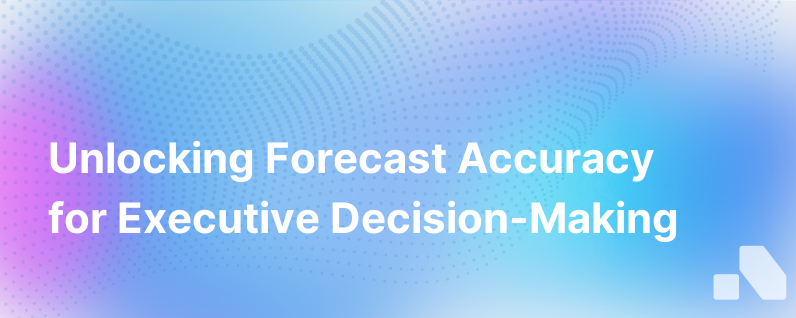
Forecasting is an essential aspect of business strategy, serving as the compass that guides financial planning and resource allocation. But mastering the art of accurate forecasting is akin to chasing a mirage in the world of sales. The paradox of forecast accuracy lies in the inherently unpredictable nature of the future; a precise forecast is often elusive due to the multitude of variables at play.
However, inaccuracy in forecasting can have far-reaching consequences – from diminished stakeholder confidence to misguided business decisions. The key lies not in attempting to eliminate uncertainty, but rather in mitigating its impacts and improving the reliability of forecasts. In this comprehensive article, we'll delve into strategies to solve the paradox of forecast accuracy in sales and business planning.
Understanding the Forecasting Paradox
On one hand, organizations crave accurate forecasts to ensure business continuity and steady growth, and on the other hand, the ever-evolving market dynamics render such forecasts challenging. The paradox manifests when businesses strive for precision in an unpredictably fluid environment.
Several factors contribute to this forecast accuracy paradox:
- Dynamic Market Conditions: Economic shifts, sudden market trends, and competitive actions can upset even the best-laid plans.
- Complex Buyer Journeys: The non-linear and multifaceted nature of modern buyer journeys with varying customer needs and unpredictable behaviors adds to the complexity.
- Data Overload: The abundance of data can lead to analysis paralysis, with the challenge of distinguishing signal from noise.
- Internal Biases: Cognitive biases and over-optimism within sales teams can skew forecast data.
Strategies to Navigate Forecasting Challenges
Despite the difficulties, improving forecast accuracy is not an exercise in futility. With the right tools and approaches, organizations can significantly enhance their forecasting capabilities. Here’s how:
Embrace a Data-Driven Culture
Organizations should instill a data-oriented culture that emphasizes the importance of data integrity and analysis. Key steps include:
- Standardize Data Collection: Implement uniform data entry protocols across teams.
- Qualitative Meets Quantitative: Fuse quantitative metrics with qualitative insights for a more holistic forecast.
- Utilize Predictive Analytics: Leverage advanced analytics and machine learning to uncover patterns and predictive factors in sales data.
Harness Technology Solutions
Investing in sophisticated CRM systems and AI forecasting tools can help manage the complexities of sales data and generate more reliable forecasts. Technologies such as Aomni can automate the aggregation and analysis of sales data, offering actionable insights with greater accuracy.
Incorporate Scenario Planning
Rather than relying on a single deterministic forecast, scenario planning paves the way for agility by outlining potential future states based on different variables, including best-case, worst-case, and most likely scenarios.
Iterate with Rolling Forecasts
Shift away from static annual forecasts to rolling forecasts that are continuously updated. This dynamic approach allows businesses to adapt to changing circumstances and refine predictions with up-to-date information.
Involve Cross-functional Teams
Cross-pollination of ideas and collaboration across sales, finance, marketing, and operations can yield a more accurate and encompassing view of the forecast.
Strengthen Communication Channels
Foster transparent communication channels for sales teams to report on-the-ground realities and pipeline changes swiftly, helping recalibrate forecasts as required.
Implement Continuous Training and Feedback
Educating the team on market shifts, forecasting techniques, and the importance of data accuracy, paired with regular feedback loops, will enhance forecasting efforts.
Review and Reconcile Regularly
Consistently review forecasts against actual outcomes to identify discrepancies and adjust forecasting models accordingly. This retrospective learning process is crucial for continuous improvement.
Recognize Uncertainty
Acknowledge the uncertain aspects of forecasts and factor in risk assessments. Establishing a risk-adjusted range in forecasts can mitigate the impacts of unforeseen events.
Forecast Accuracy: A Journey, Not a Destination
Sales forecasting will always harbor elements of uncertainty; it's about finding balance amidst chaos. Rather than chasing static accuracy, the focus should be on flexibility, the speed of adjustment, and continuous learning.
The journey to improved forecast accuracy is paved with persistent iteration, learning, and the willingness to embrace uncertainty while exerting control over what can be predicted. Organizations that recognize this and continue to hone their forecasting techniques will find themselves better positioned to navigate the unpredictable tides of the business world.
While Aomni is not a crystal ball that can guarantee forecast accuracy, it is designed to significantly enhance the robustness of your forecasting mechanisms by providing real-time account research, competitive insights, and personalized sales content. These tools reduce the effort required to compile forecasts while ensuring they are as informed and as actionable as possible.
In conclusion, solving the paradox of forecast accuracy does not require a magician’s trick, but rather a strategic and systematic use of resources, collaboration, training, and technology like Aomni. These elements, combined with an understanding that forecasts are perpetually evolving reflections of business health, will guide you to make more informed and thus more profitable decisions in the face of uncertainty.